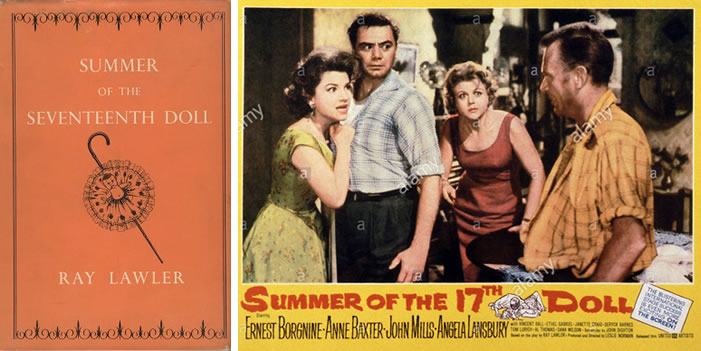Ray Lawler: Summer of the Seventeenth Doll |

Summer of the Seventeenth Doll was written by Ray Lawler and first performed at the Union Theatre in Melbourne on 28 November 1955.
The play is considered to be the most significant in Australian theatre history, and a "turning point", openly and authentically portraying distinctly Australian life and characters. It was one of the first truly naturalistic "Australian" theatre productions.
It was originally published by Angus & Robertson, before moving to Fontana Press and then Currency Press
The play is set in Australia, in the Melbourne suburb of Carlton and it details the events of the summer of 1953, in the lives of six central characters.
The structure of the play is such that the nature of these characters and their situation and history is not revealed immediately, but rather gradually established as the story unfolds. By the end, the story and all its facets have been indirectly explained.
The summer that the story spans marks the 17th year of an annual tradition in the lives of the characters, wherein two masculine sugarcane cutters, Arthur "Barney" Ibbot and Reuben "Roo" Webber, travel south to Melbourne for five months of frivolity and celebration with two city women, Olive Leech and Nancy (Roo bringing with him as a gift for Olive a kewpie doll, hence the name of the play). One of the women, Nancy, has apparently married some months before, and she is not present in the play, so in her place Olive has invited Pearl Cunningham to partake in the tradition. The other women present in the play are Kathie "Bubba" Ryan, a 22-year-old girl who has been coveting Olive and Nancy's lifestyle from her neighbouring house almost all her life, and Emma Leech, Olive's cynical, irritable, but wise mother.
As the play progresses, it becomes obvious that, for many collective reasons, this summer is different from others; it is full of tensions, strains to recreate lost youth, and from what is said of previous years, not a fraction of the fun that others have been. Steadily things become worse; Roo is revealed to be broke and is forced to take a job in a paint factory. He is disillusioned with his age and weaknesses, while relations between Barney and him are in doubt, due to a recent question of loyalty. The situation is agitated in part by Pearl's uptight indignation and refusal to accept the lifestyle she is being presented with as "proper" or "decent".
The play ends with a bitter fight between Olive and Roo after he proposes marriage to her and she is affronted, threatened by the prospect of any lifestyle other than the one to which she is accustomed. In the final scene, the two men leave together, the summer prematurely ended and the characters' futures uncertain.
Summer of the Seventeenth Doll is part of a trilogy generally referred to as the Doll Trilogy; the story of The Doll is preceded by the prequels Kid Stakes (1975), set in 1937, which tells the story of the first year of the tradition and the origin of the gift of the Kewpie doll, and Other Times (1976), which is set in 1945 and includes most of the same characters.
The iPad app
In 2013 Currency Press released an iPad app which charts the 57-year history of Summer of the Seventeenth Doll.
The app collates archival material from the first production on 28 November 1955 up until the most recent Belvoir production, which toured the east coast of Australia in 2011/12. Material was sourced from a range of archives and institutions along the east coast of Australia.
❊ Web Links ❊
➼ Ray Lawler: Summer of the Seventeenth Doll
Disclaimer: Check with the venue (web links) before making plans, travelling or buying tickets.
Accessibility: Contact the venue for accessibility information.
Update Page








